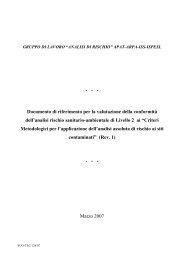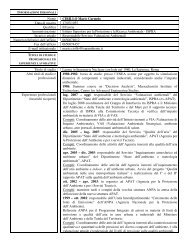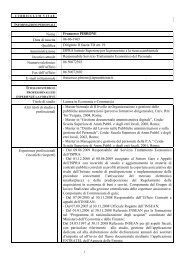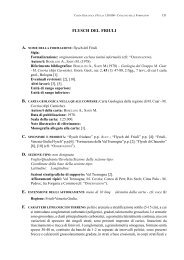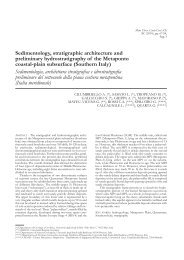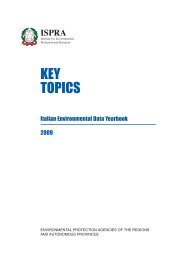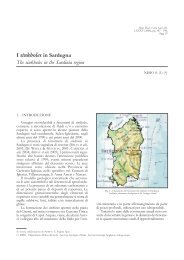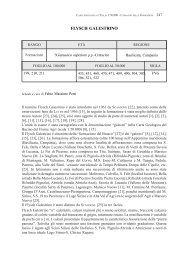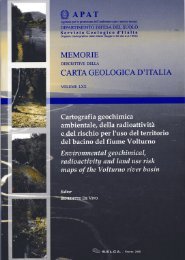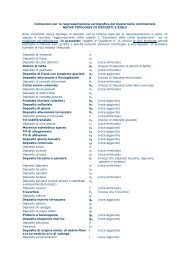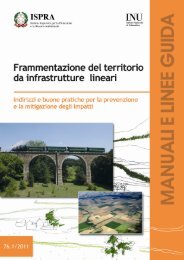Guidebook - Ispra
Guidebook - Ispra
Guidebook - Ispra
Create successful ePaper yourself
Turn your PDF publications into a flip-book with our unique Google optimized e-Paper software.
Volume n° 1 - from PR01 to B15<br />
B12<br />
B12 -<br />
Leader: M. Sandulescu<br />
the Devonian.<br />
Upper Paleozoic and Mesozoic. The formations<br />
overlying the Variscan and pre-Variscan basement<br />
are the following: Permian red-beds; Lower Jurassic<br />
Gresten facies deposits (conglomerates, sandstones);<br />
Middle Jurassic sandstones with carbonatic matrix;<br />
Upper Jurassic-Lower Cretaceous massive limestones;<br />
Middle Cretaceous shales (Nadanova beds);<br />
Upper Cretaceous turbidites, reaching into the Senonian.<br />
A special mention has to be made of the northern part<br />
of the Lower Danubian Mesozoic displaying very<br />
low metamorphism: the Liassic Schela Formation<br />
(metaconglomerates and phyllites with chloritoid and<br />
pyrophyllite); the Upper Cretaceous volcaniclastic<br />
sandstones with prehnite and pumpellyite.<br />
Upper Danubian Nappes<br />
Metamorphic basement.<br />
The Upper Danubian Nappes are exposed in the<br />
northern and western parts of the Danubian Window.<br />
The Zeicani Group represents the polymetamorphic<br />
basement of several nappes and consists of a prevailing<br />
amphibolitic sequence, with associated leptynites<br />
and mica gneisses (± kyanite, staurolite) generally affected<br />
so strongly by retrogression that they look like<br />
greenschists or sericite schists. Berza and Seghedi<br />
(1983) compare this group with the Drăgșan Group of<br />
the Lower Danubian.<br />
The metaterrigenous Măgura Marga Group consisting<br />
of a prevailing quartzitic sequence, muscovite<br />
plagiogneisses, amphibolites, is highly migmatised.<br />
It was compared by Berza and Seghedi (1983) to the<br />
Lainici-Păiuș Group of the Lower Danubian.<br />
The two groups of metamorphic rocks (and others<br />
with restricted extension) are intruded by granitoid<br />
plutons (Muntele Mic, Sfârdinu, Cherbelezu,<br />
Ogradena, etc); special mention has to be made of<br />
the mafic-ultramafic Tisoviţa-Iuţi complex. The<br />
dextral Cerna-Porecˇka Reka fault system with a<br />
horizontal displacement of 40 km (trending NE) has<br />
dismembered a formerly much larger ophiolitic body,<br />
the southern part of which consists of the Deli Iovan<br />
massif of Serbia.<br />
The K-Ar model ages of samples from the Upper<br />
Danubian metamorpfic rocks and associated granitoids<br />
range between 447 and 96 M.a., demonstrating<br />
Variscan and Alpine reworking of the basement<br />
(Grünenfelder et al., 1983).<br />
Lower and Middle Paleozoic very low-grade formations<br />
are represented by the following: Nijudimu-<br />
Râu Alb Formation (Ordovician-Silurian phyllites,<br />
conglomerates, sandstones, mafic tuffs); Brustur<br />
Formation (probably Silurian conglomerates); Râul<br />
Rece-Drencova Formation (Devonian conglomerates,<br />
sandstones, slates, mafic tuffs and flows); Sevastru<br />
Formation (Lower Carboniferous limestones, slates,<br />
sandstones, mafic volcanics). With the exception of<br />
the latter which bears macrofaunal remains (Spiriferidae,<br />
etc), the ages of the former formations are<br />
constrained by palynological associations.<br />
But south of the Danube, in the Stara Planina Unit,<br />
the oldest fossiliferous formation is found as blocks<br />
in a Devonian olistostrome; its Arenigian age is constrained<br />
by Acritarchs. In the same unit, the Upper<br />
Silurian and the Devonian could be parallelized with<br />
the Drencova Formation, the age of the former being<br />
proved by Tabulate Corals.<br />
Upper Paleozoic and Mesozoic<br />
The formations overlying the Variscan and pre-Variscan<br />
basement are developed in two main zones:<br />
Sviniţa- Arjana and Cornereva-Mehadia.<br />
The following are to be mentioned: Upper Carboniferous<br />
coal-bearing conglomerates, sandstones and<br />
slates; Permian red-beds with rhyolitic volcanic<br />
and volcaniclastic rocks; Lower Jurassic coal-bearing<br />
conglomerates, sandstones and slates (“terres<br />
noires”), sometimes developed in Schela anchimetamorphic<br />
facies; Middle-Upper Jurassic, represented<br />
either by a volcano-sedimentary formation with mafic<br />
and alkaline lava flows, pyroclastic deposits, limestones<br />
and shales (Arjana), or by limestones (Sviniţa);<br />
Upper Cretaceous flysch (Arjana).<br />
The intensity of Alpine metamorphism varies in these<br />
formations between high-grade diagenesis and lowgrade,<br />
increasing eastwards.<br />
Severin Nappe. The Severin Nappe in the South<br />
Carpathians consists of obducted slices generated<br />
in a rift with oceanic or thinned continental crust,<br />
formed in the Jurassic on the European margin. It<br />
includes a Upper Jurassic tectonic melange (olistoliths<br />
of basalts, gabbros, serpentinites, harzburgites,<br />
crystalline schists, limestones, in a matrix of siliceous<br />
marly pelagic deposits-anchimetamorphic Azuga<br />
beds), and Upper Jurassic-Lower Cretaceous flysch<br />
deposits (Sinaia beds: distal limestone turbidites with<br />
a microfauna of Calpionellids). In Serbia, this unit<br />
corresponds to the Kosovica and Sub-Kosovica Nappes<br />
(Grubic´ et al., 1997).<br />
Getic Nappe Metamorphic basement.<br />
The L o t r u G r o u p represents the basement of the<br />
main part of the Getic Nappe, extending over more<br />
than 300 km in length and 80 km maximal width on



